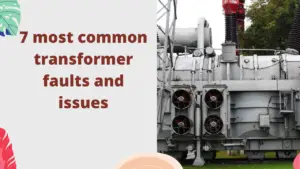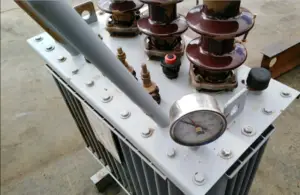Table of Contents
What is a transformer?
Before we dive into what happens when a transformer goes bad, it’s important to understand what a transformer is and how it works.
A transformer is an electrical device that is used to transfer electrical energy from one circuit to another through electromagnetic induction. It is made up of two coils of wire, called the primary and secondary coils, which are wrapped around a core made of iron or other magnetic materials.
When an alternating current (AC) flows through the primary coil, it creates a magnetic field around the core, which then induces a current in the secondary coil. The amount of current that is transferred depends on the number of turns in each coil and the properties of the core material.
What happens when a transformer goes bad?
When a transformer fails, the consequences can be significant and potentially dangerous.
One of the most noticeable signs of a failed transformer is a loud boom, which can be heard from some distance from the transformer’s location.
This boom is usually caused by an internal failure in the transformer, such as a short circuit or arcing, which can produce a sudden release of energy in the form of heat and pressure.
In addition to the boom, a failed transformer can also cause a power outage in the surrounding area.
Since transformers are a critical link in the electrical grid, a failure in one can have a ripple effect on the entire system, potentially causing widespread outages and disruptions.
These outages can last for hours or even days, depending on the severity of the failure and the availability of replacement parts.
In some cases, a failed transformer can also create a fire, which can be particularly dangerous if the transformer contains oil or other flammable materials.
This fire can produce a large plume of smoke, which can be toxic and pose a health risk to nearby residents.
Unfortunately, the process of fixing a failed transformer can take time, as it often involves replacing damaged components or even the entire transformer itself.
During this time, residents in the affected area may need to rely on backup power sources or make alternative arrangements for electricity, such as staying with friends or family or using generators.
If you suspect that a transformer in your area has failed, it’s important to contact your utility company immediately to report the issue and receive updates on the status of repairs.
Want to learn more? Click here to explore my in-depth article about How to tell if the transformer is going bad.
what happens to 3-phase loads if one phase of the transformer fails
If one phase of a transformer fails while powering a three-phase load, the consequences can vary depending on the type of load and the degree of the load imbalance caused by the failed phase.
In general, the load will experience a reduction in power output and may become unbalanced. This is because the three-phase load is designed to receive power from three separate phases, and the loss of one phase will disrupt the balance of the load. The degree of imbalance will depend on the type of load and its power requirements.
- For example, a balanced three-phase load, such as a three-phase motor, may continue to operate, but with reduced power output and increased heating due to the increased current flow in the remaining two phases. In this case, the load imbalance can cause the motor to run inefficiently and potentially overheat, which can lead to motor failure.
- On the other hand, an unbalanced three-phase load, such as a single-phase lighting system connected to a three-phase supply, may be more severely affected by the loss of one phase. In this case, the load may experience a significant reduction in power output and may even fail completely, depending on the degree of the load imbalance caused by the failed phase.
It’s important to note that the severity of the consequences of a failed phase will depend on the load type and its specific requirements, as well as the duration of the failure.
In any case, it’s important to identify and fix the issue causing the failure as soon as possible to prevent further damage and potential safety hazards.
when transformer goes bad does power still flow
When a transformer goes bad, the flow of power may be affected depending on the type and severity of the failure.
If the transformer is completely destroyed or disconnected from the power source, no power will flow through the transformer.
However, if the transformer has only partially failed, it may continue to allow some power to flow through it.
- In some cases, a failed transformer may result in a decrease in power output or an increase in power loss due to increased resistance in the transformer’s windings. This can lead to reduced efficiency and potentially even damage to the transformer or the equipment it is powering.
- In other cases, a failed transformer may cause a complete loss of power, either by tripping a protective device such as a circuit breaker or fuse or by causing a short circuit or another electrical fault. This can result in a sudden loss of power to the affected equipment and potentially cause damage or safety hazards.
can a bad transformer affect the grid?
Yes, a bad transformer can affect the electrical grid, especially if the transformer is part of a substation that is connected to the grid.
Substations are used to convert high-voltage electricity from the transmission lines into lower-voltage electricity that can be distributed to homes and businesses. Transformers are a critical component of substations, and if a transformer fails, it can cause disruptions in the power grid.
When a transformer fails, it can cause a sudden loss of power to the surrounding area. Depending on the location and capacity of the transformer, this loss of power can affect thousands of customers. In addition, a transformer failure can cause a surge in electrical current that can damage other equipment and cause further power outages.
In some cases, a transformer failure can also cause voltage fluctuations or power quality issues on the grid. This can affect the performance of other equipment connected to the grid, such as motors, computers, and electronic devices.
can a bad transformer affect my home appliances?
Yes, a bad transformer can affect your home appliances, depending on the location and severity of the failure.
Transformers are responsible for stepping down the voltage of the electricity supplied to homes and businesses from the power grid to a level that is safe for use by household appliances. A transformer failure can cause a voltage surge, voltage drop, or other electrical irregularities that can damage or disable home appliances.
- For example, a voltage surge caused by a failing transformer can overload the electrical components in your appliances, causing them to fail or malfunction. A voltage drop, on the other hand, can cause your appliances to run at reduced power, which can lead to decreased performance and potential damage over time.
- In addition, a transformer failure can also cause power outages, which can disrupt the operation of appliances and other electrical devices in your home. If a power outage lasts for an extended period, it can also cause food spoilage and other problems.
It’s important to note that many factors can affect the extent to which a transformer failure affects your home appliances, including the location and capacity of the transformer, the type and quality of your appliances, and the duration and severity of the electrical irregularities caused by the failure.
If you suspect that a transformer failure has affected your appliances, it’s important to have a licensed electrician inspect your electrical system and appliances to determine the extent of the damage and recommend appropriate repairs or replacements.
In addition, you should contact your utility company to report the issue and request that they investigate and repair the transformer as soon as possible to prevent further damage and disruptions.
What causes A transformer to go bad?
Like any other electrical device, transformers can fail or go bad over time. There are several reasons why a transformer might fail, including:
- Overheating: Transformers can overheat if they are exposed to high temperatures or if they are overloaded with too much current. Overheating can cause the insulation on the wires to break down, which can lead to a short circuit.
- Age: Transformers can also fail simply due to age. Over time, the insulation on the wires can become brittle and crack, which can lead to a short circuit.
- Physical damage: Transformers can also be damaged if they are dropped or bumped, or if they are exposed to water or other liquids.
- Electrical surges: Electrical surges, such as lightning strikes or power surges, can also damage transformers.
Signs of bad transformer going bad
When a transformer goes bad, there are several signs that you might notice:
- Noise: A failing transformer can produce a buzzing or humming noise.
- Smell: A burning smell or the smell of hot metal can indicate that a transformer is overheating.
- Heat: A transformer that is overheating will feel hot to the touch.
- Loss of power: If a transformer fails completely, it can cause a loss of power to the circuit it is connected to.
- Flickering lights: A failing transformer can cause lights to flicker or dim.
What to do when a transformer goes bad?
If you suspect that a transformer has gone bad, it’s important to take action to prevent further damage or potential safety hazards. Here are some steps you can take:
- Shut off power: If you notice any signs of a failing transformer, the first thing you should do is shut off power to the circuit it is connected to. This can help prevent further damage or potential safety hazards.
- Check for damage: Once you have shut off power, you can inspect the transformer for any physical damage, such as cracks or breaks in the casing.
- Call a professional: If you are not experienced with electrical work, it’s best to call a professional to inspect and repair the transformer. Attempting to repair a transformer yourself can be dangerous and can cause further damage.
Conclusion
Transformers are essential components in many electrical systems, but they can fail over time due to a variety of reasons. If you suspect that a transformer has gone bad, it’s important to take action to prevent further damage or potential safety hazards.
By shutting off power and calling a professional, you can ensure that the transformer is inspected and repaired safely.
Don’t Leave Empty-Handed!
Install my Free Android App on Google Play:
Electrical Cables Most Common Tables “Cables Tables”
And, my Electrical Calculations App “Fast Electrical Calculator”
Discover more great content by subscribing to My channel
Looking to stay ahead of the game in the world of electrical engineering? Subscribe to my YouTube channel and gain access to exclusive content you won’t find anywhere else!
The staff I recommend
(Amazon Affiliate Links to products I believe are high quality):
- Economy 120 Volt/60Hz AC Power Source – Step-Down Voltage & Frequency Converters 1800W
- UNI-T Digital Multimeter Tester UT139C
- 50-Amp Extension Cord for RV “100ft”
- Voltage Stabilizer 110/220v
- Hair Dryer “best selling“
- TOSHIBA EM131A5C-BS Countertop Microwave Ovens
Disclaimer: This contains affiliate links to Amazon products. I may earn a commission for purchases made through these links.


